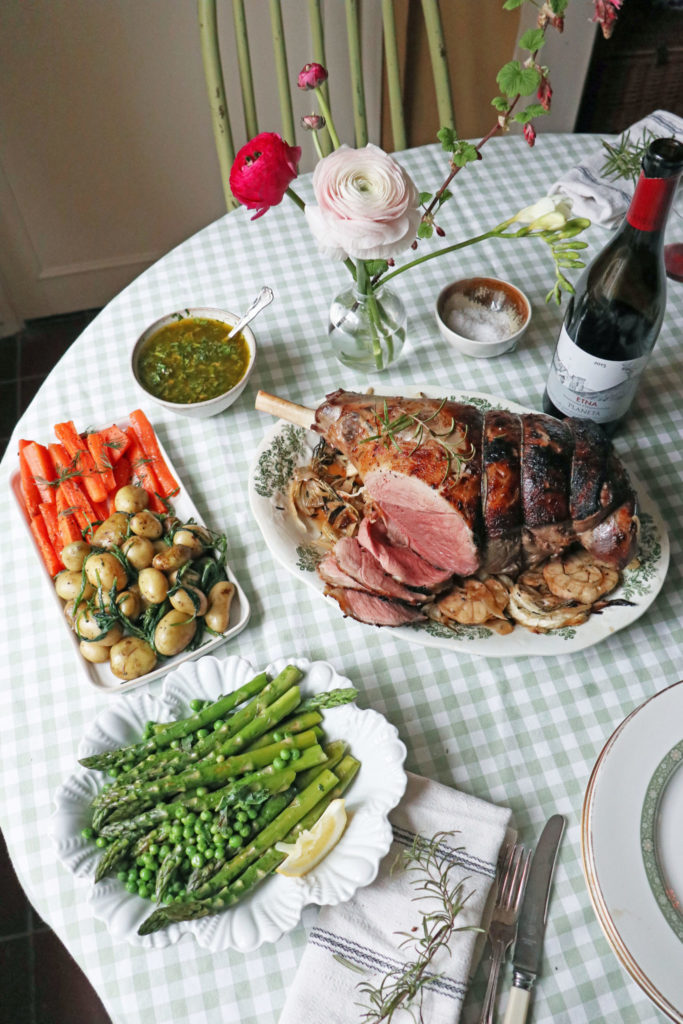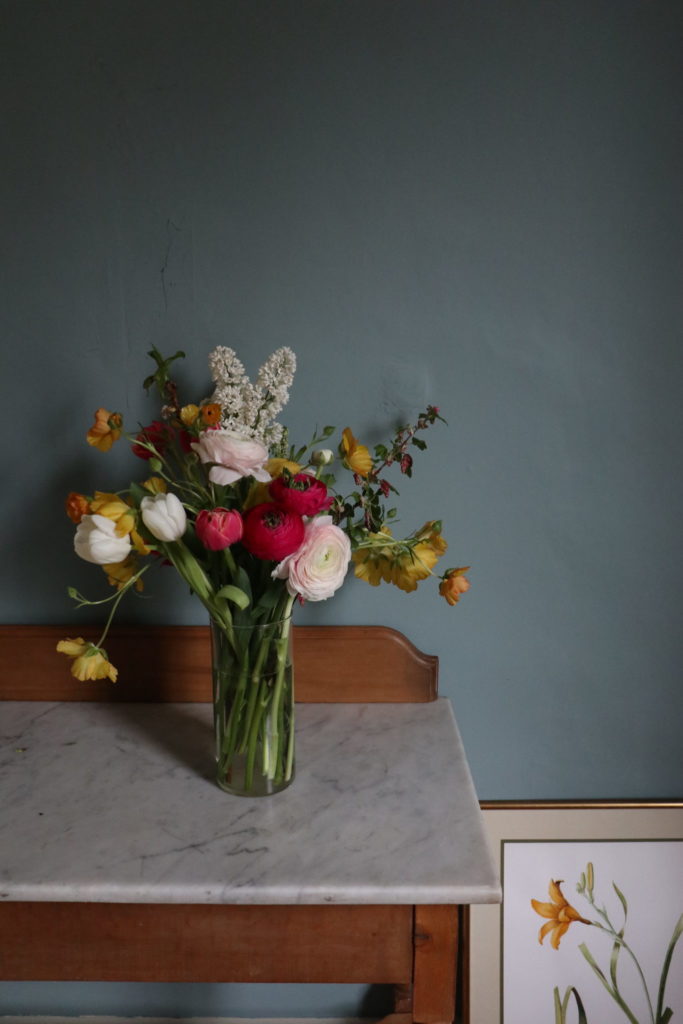
My husband tells me off for saying this so often (usually while walking the dog and squirreling wild garlic away into my pockets), but spring really is my favourite time of year, and I’d be lying if I said this didn’t have A LOT to do with the very special ingredients that come our way during the green, verdant months before the heat of high summer.
We are so lucky in the UK, I believe, with the pronounced seasonality reflected in our ingredients, and it’s for that reason that I get so excited about spring. As a girl I remember how excited we used to get about the tradition of sharing roast spring lamb around the table, and for this reason, I’m sharing recipes here for a spring lamb feast – a perfect roast to share with those you love during the spring and early summer months while we have such treasures as British asparagus and Jersey royal potatoes at our fingertips.
How can you improve on classic roast spring lamb? Sourcing is the first step. The lamb I used for this meal was from the butcher counter at Harrods, after a long chat with Michael the butcher, who has worked there for over 10 years and is a fount of knowledge. He helped me pick out a beautiful leg of lamb from Walter Rose and Sons in Wiltshire, where animal husbandry and welfare are of a really high standard, something you know is really important to me on the occasions that I choose to eat meat. Seek out the best you can find from a trusted supplier or butcher and you will be halfway there.
Secondly, I decided to lightly cure the lamb to further emphasise its amazing flavour. Pink Himalayan salt is perfect for this, thanks to its superior flavour and the fact it contains added trace minerals, but a lovely sea salt such as Maldon or Fleur de Sel works well too. I mixed some of this with some rosemary, garlic and thyme salt, to emphasis the herbaceous flavours of the meat. Quick curing like this draws out some of the moisture in the meat, thereby concentrating the flavours, and works to make it more tender too. It’s such an easy thing to do to get the absolute best out of your meat.
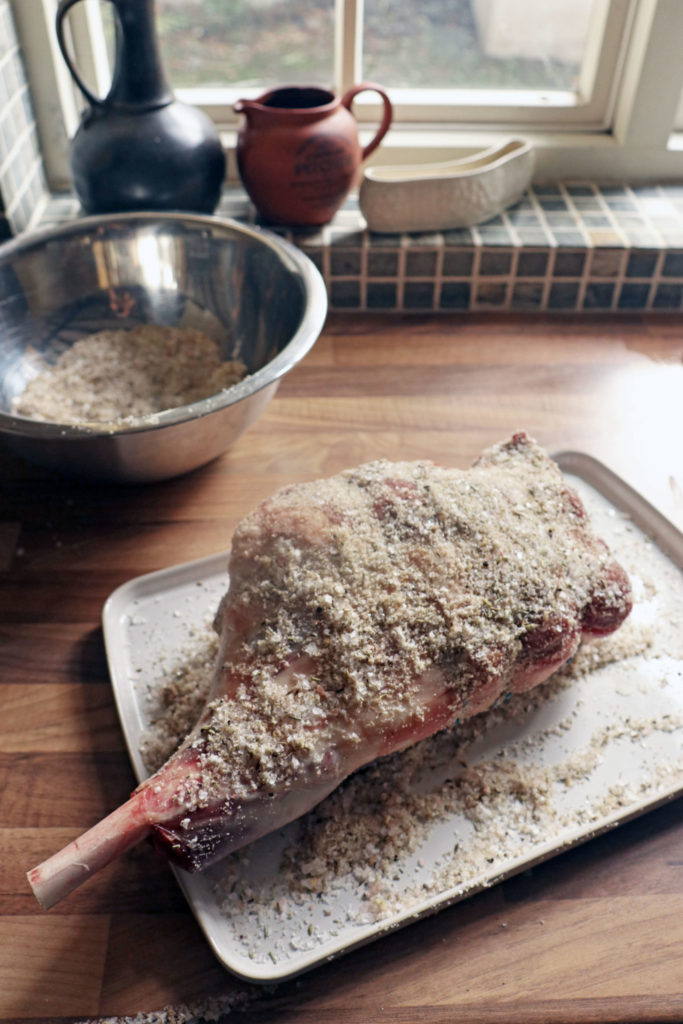
Then of course, the cooking – I’ve just got a wood oven in Deal and have been like an excited kid wanting to cook everything in it, so naturally I jumped at the chance to use it for the lamb – and curing also helps meat to pick up smoky flavours in a wood oven. Don’t worry if you don’t have a wood oven (I know most people don’t), you can still follow these methods and the curing is worth doing even if you’re cooking in a conventional oven.
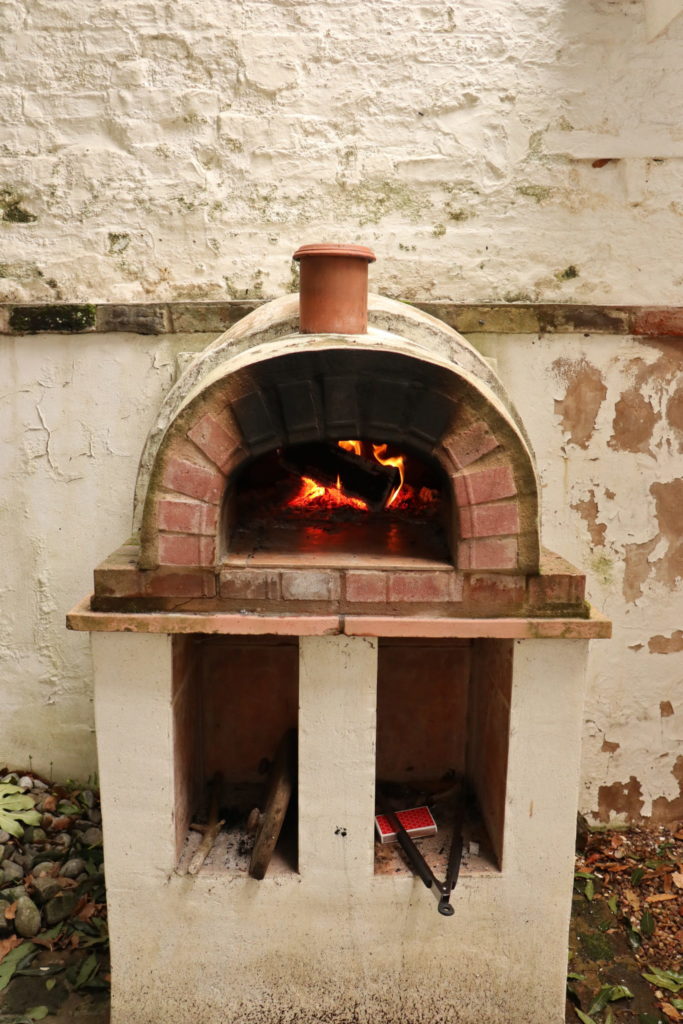
Accompaniments at this time of year are almost as exciting as the main event, and you know how much I love Jersey potatoes, so of course they had to star in this menu. I cooked them with a little bit of juicy, salty samphire and tossed them in some melted butter and wilted wild garlic I foraged locally. Their earthy, mineral flavour is just divine with the sweet, herbaceous flavours of the lamb. Heaven!
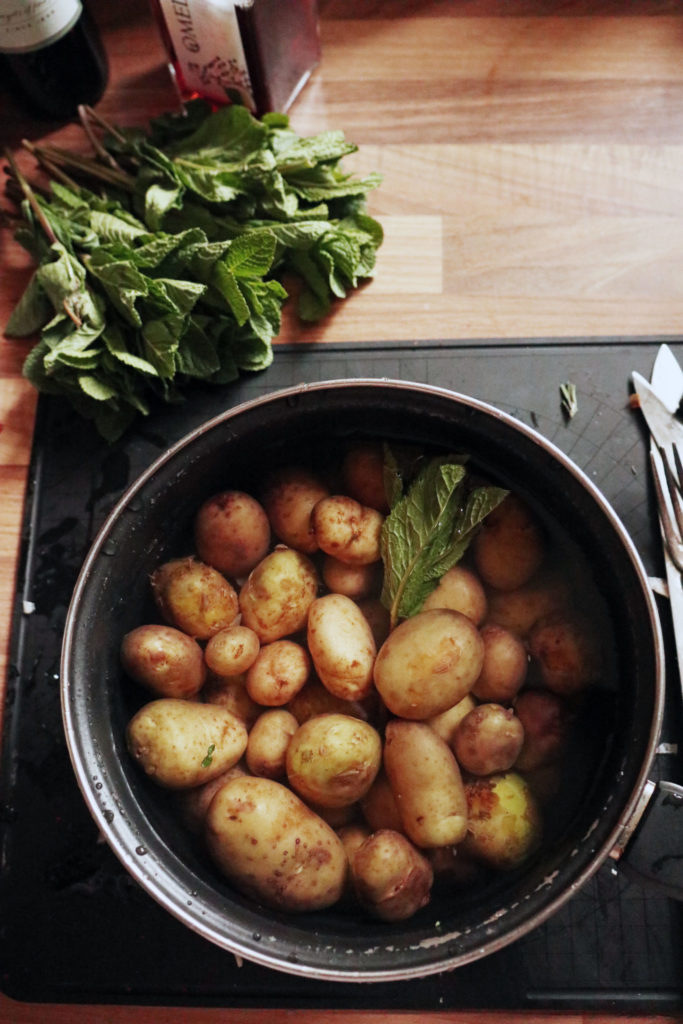
The first of the British asparagus is always a massive treat, and I love to keep it simple to let the special flavour sing, often just dressing it in a little melted butter with a squeeze of lemon, but Harrods do this gorgeous lemon infused olive oil which is just perfect for this. You know how much I love a salsa verde, and it works so beautifully with lamb, thanks to the punchy anchovies, capers and garlic as well as the mixture of aromatic soft herbs. I like to serve a big bowl of it at the table for people to dress their own plates, and this can always be made ahead to save you a job when you’re getting all the sides together.
I hope you enjoy these recipes. As always, let me know how you get on and share pics with me on Instagram and Twitter – I love to see when you’re cooking from the blog.
Celebratory spring lamb feast
For the lamb
140g pink Himalayan or sea salt
140g garlic, rosemary and thyme salt
200g granulated sugar
½ tsp fennel seeds
2kg bone-in leg of lamb
(ask the butcher to remove the h bone for you to make it easier to carve)
Olive oil
1 bulb of fennel, finely sliced
2 roscoff onions, sliced
Zest of 1 lemon
1 large head of fresh garlic, split
3 bay leaves
1 bunch of rosemary
Tbsp plain flour
40ml white wine
For the salsa verde
1 bunch tarragon, stalks removed
1 bunch mint, stalks removed
1 bunch flat leaf parsley, stalks removed
4 anchovy fillets, chopped
1 tbsp capers, chopped
1 clove garlic, minced
100ml extra virgin olive oil
50ml red wine vinegar
1 tbsp Dijon mustard
Buttered Jerseys with samphire and wild garlic
800g Jersey potatoes
100g samphire
50-100g wild garlic
Unsalted butter
Carrots with dill
300g carrots, peeled and sliced into batons
1 bunch of dill
Butter
Peas, asparagus and lemon oil
500g asparagus, woody stalks snapped off
300g fresh peas, podded
lemon-infused olive oil (or olive oil whisked with the zest of 1 lemon)
Bunch of fresh mint
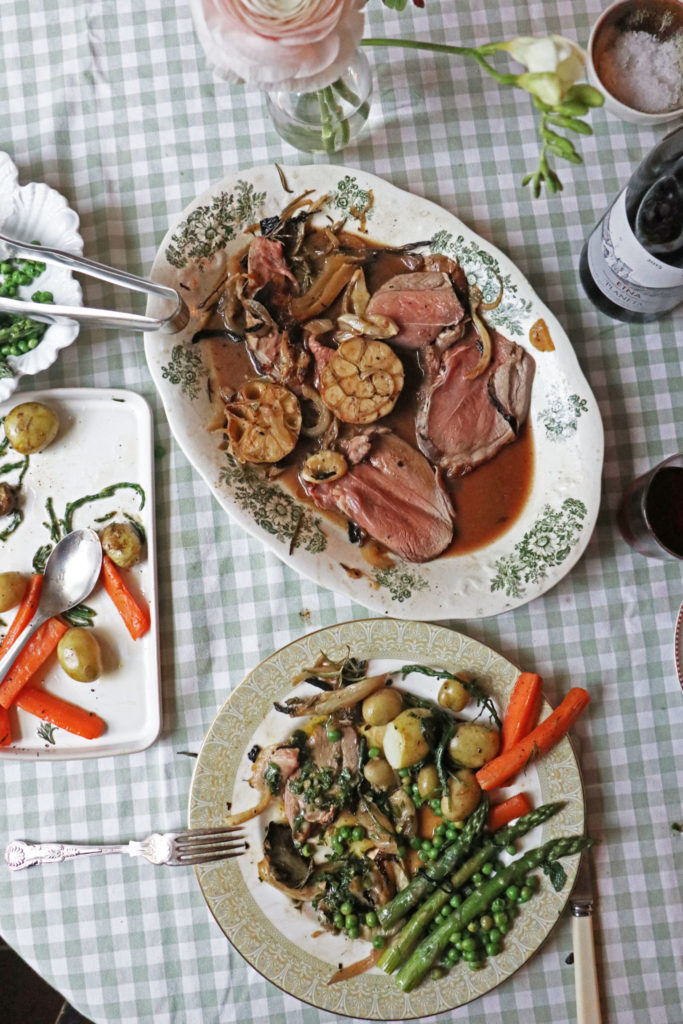
You need to prepare the cure the day before, but it really could not be easier. In a bowl, combine the pink salt, herb and garlic salt, sugar and fennel seeds. Place the lamb leg in a roasting tray or on a platter and use a knife to make a few incisions in it all over. Cover with the cure, pressing it all over the leg to form a sort of crust. Refrigerate until the next day.
The following day, remove the lamb from the fridge and gently rinse off the cure under tepid water. You’ll notice the skin and fat have gone a deeper colour and feel slightly tacky – this will help the meat absorb the smoky flavour of the wood oven, if you’re using one.
If you are using a wood oven, you need to build a fire to get things really hot a few hours before you plan on cooking. I would start three hours before with a base of coal, kindling and four logs built at parallels to each other, and keep adding logs to the fire. Once you get to within 1 hour of cooking, take the lamb out of the fridge to come up to room temp, and place one more log on the fire. Just before cooking, use a fire tool to move the burned down logs to the side of the oven, making room for the roasting tray. If you’re using a conventional oven, preheat to 200 degrees c fan.
In a roasting tray, combine the sliced onions, fennel, garlic, bay, lemon zest and rosemary with a little slosh of olive oil. Place the lamb on top and cover with foil. Place in the oven and cook for one hour. After an hour, remove the foil and cook for a further 20-30 mins, depending on how rare you like it. Remove from the oven, place the lamb on a platter and cover with foil and some tea towels. Rest for one hour. Skim any fat from the surface of the roasting tray into a bowl and whisk with a tbsp of plain flour. Place the roasting tray and its contents over a hob and turn on the heat, pour in the flour mix and whisk to incorporate, then add the wine. Cook until the wine has almost evaporated, then add in a cup or so of water or any stock you might have. Cook, whisking, for a few mins until you’ve cooked out the flour and have some lovely juices to serve with the lamb.
In the meantime, gather the serving bowls and dinner plates you’re going to use for the sides and to eat from, and place them in a warm oven (100 degrees) to keep warm. I always try and do this before it gets to crunch point so that they are ready to go for a smooth service.
While the lamb is resting, get on with the sides and salsa verde. To make the salsa, finely chop all of the herbs and place in a mixing bowl. Add the olive oil and whisk in the vinegar and Dijon. Stir through the anchovies and capers. Taste for seasoning and if it needs piquing (it should make you salivate in a good way when you taste it), add a dash more vinegar or olive oil. Set aside.
Cover the Jerseys with water, a tsp of salt and a sprig of mint and bring to the boil. Cook for 10-12 mins, until tender. During the last min, throw the samphire in there too and cook until tender – a minute or so. Drain. Melt a good knob of butter in a frying pan and wilt the wild garlic in there, then toss in the Jerseys and samphire and coat in the wild garlic butter. Cover and keep warm.
Place the carrots in a pot. Add in a big pinch of salt and sugar and cover with boiling water. Bring back the boil, cover, and cook until tender – 8-10 mins depending on the thickness of your batons. You want the carrot to slip from the blade of a sharp knife with no resistance. Once cooked, drain and toss with a knob of butter and a handful of chopped dill. Cover and keep warm until serving.
I would do the asparagus and peas just before serving. For the asparagus and peas, bring another pan of salted water to the boil. Poach the asparagus for 2 mins, then add the peas and cook for another two mins, until tender. Drain immediately and pour into your warm serving dish, drizzle over some of the lemon oil and toss to coat, then garnish with chopped fresh mint, sea salt and black pepper.
Warm the contents of the roasting tray until piping hot. Remove the foil from the lamb, place it on a chopping board and carve. Place the veg and juices from the roasting tray on the platter and top with the carved lamb.
Take everything to the table and devour.
